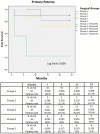Outcomes of arteriovenous fistula reconstruction in vascular access dysfunction
- PMID: 30899405
- PMCID: PMC6413263
Outcomes of arteriovenous fistula reconstruction in vascular access dysfunction
Abstract
Background: Complications such as stenosis, thrombosis, aneurysmal dilatation, and infection occur in at least one-third of all arteriovenous fistulas (AVFs). Due to these complications, vascular access dysfunction develops in hemodialysis patients.
Objectives: We investigated AVF rescue operations, which we performed for the pathologies causing dysfunctional vascular access, and outcomes of these operations by surgeon-performed preoperative ultrasound (US) in our clinic.
Design: Retrospective Study.
Settings: Bursa Yüksek Ihtisas Training and Research Hospital Cardiovasculary Surgery Department, Turkey.
Patients and methods: 67 patients who were treated in our clinic due to AVF dysfunction between January 2012 and January 2016 were included in the study. Preoperative US evaluation for dysfunctional AVFs was performed by the surgeon conducting the operation. The patients were divided into 5 groups according to the pathologies such as stenosis, thrombosis, aneurysm, high-flow rate, and deep basilic vein.
Main outcome measures: Our goal in all patients with vascular access dysfunction was to maintain the AVF.
Sample size: 67 Patients.
Results: In Group 1 (16 patients) which had stenosis and underwent AVF reconstruction, the 24-month primary patency rate was 81.3%. In Group 2 (9 patients) which had trombosis and underwent AVF reconstruction, the 24-month primary patency rate was 22.2%. In Group 3 (24 patients) which had AVF aneurysm and underwent AVF reconstruction, the 24-month primary patency rate was 70.8%. In Group 4 (10 patients) which had high flow and underwent AVF reconstruction, the 24-month primary patency rate was 90%. In Group 5 (8 patients) which had deep basilic vein and underwent AVF reconstruction, the 24-month primary patency rate was 75%.
Conclusion: Leaving patients with vascular access dysfunction to fate (no intervention) or AVF ligation is always simpler and easier. However, it should not be forgotten that paternity for vascular access are limited in these patients. We think that the primary target is to demonstrate AVF by physical examination and surgeon-performed detailed US and to make it again available for hemodialysis by reconstructing dysfunctional AVF using the most appropriate surgical strategy.
Limitations: Retrospective, small sample size.
Keywords: Arteriovenous fistula; aneurysm; arteriovenous fistula reconstruction; stenosis; ultrasound.
Conflict of interest statement
None.
Figures




Similar articles
-
Comparison of forearm versus upper arm basilic transposition arteriovenous fistulas demonstrates equivalent satisfactory patency.J Vasc Surg. 2019 Oct;70(4):1247-1252. doi: 10.1016/j.jvs.2019.01.093. Epub 2019 May 27. J Vasc Surg. 2019. PMID: 31147119
-
Medicare Costs Associated With Arteriovenous Fistulas Among US Hemodialysis Patients.Am J Kidney Dis. 2018 Jul;72(1):10-18. doi: 10.1053/j.ajkd.2018.01.034. Epub 2018 Mar 28. Am J Kidney Dis. 2018. PMID: 29602630
-
Primary and staged transposition arteriovenous fistulas.J Vasc Surg. 2008 Jun;47(6):1279-83. doi: 10.1016/j.jvs.2008.01.047. J Vasc Surg. 2008. PMID: 18514843
-
Gender differences in vascular access in hemodialysis patients in the United States: developing strategies for improving access outcome.Gend Med. 2007 Sep;4(3):193-204. doi: 10.1016/s1550-8579(07)80040-4. Gend Med. 2007. PMID: 18022587 Review.
-
Factors affecting the patency of arteriovenous fistulas for dialysis access.J Vasc Surg. 2012 Mar;55(3):849-55. doi: 10.1016/j.jvs.2011.07.095. Epub 2011 Nov 8. J Vasc Surg. 2012. PMID: 22070937 Review.
Cited by
-
To Close, Observe, or Reconstruct: The Third Way of Managing Dialysis Fistula Aneurysms in Kidney Transplant Recipients.J Clin Med. 2021 Sep 30;10(19):4567. doi: 10.3390/jcm10194567. J Clin Med. 2021. PMID: 34640585 Free PMC article.
-
Heme Oxygenase 1/Peroxisome Proliferator-Activated Receptor Gamma Pathway Protects Intimal Hyperplasia and Mitigates Arteriovenous Fistula Dysfunction by Regulating Oxidative Stress and Inflammatory Response.Cardiovasc Ther. 2022 Jun 12;2022:7576388. doi: 10.1155/2022/7576388. eCollection 2022. Cardiovasc Ther. 2022. PMID: 35812724 Free PMC article.
-
Improved Ultrasound-Guided Balloon-Assisted Maturation Angioplasty Using Drug-Eluting Balloons in the First Autogenous Arteriovenous Fistula Procedure: Early Experience.Biomedicines. 2024 May 2;12(5):1005. doi: 10.3390/biomedicines12051005. Biomedicines. 2024. PMID: 38790967 Free PMC article.
References
-
- Salahi H, Fazelzadeh A, Mehdizadeh A, Razmkon A, Malek-Hosseini SA. Complications of arteriovenous fistula in dialysis patients. Transplant Proc. 2006;38:1261–1264. - PubMed
-
- Rajput A, Rajan DK, Simons ME, Sniderman KW, Jaskolka JD, Beecroft JR, Kachura JR, Tan KT. Venous aneurysms in autogenous hemodialysis fistulas: is there an association with venous outflow stenosis. J Vasc Access. 2013;14:126–130. - PubMed
-
- Sigala F, Kontis E, Saßen R, Mickley V. Autologous surgical reconstruction for true venous hemodialysis access aneurysms techniques and results. J Vasc Access. 2014;15:370–375. - PubMed
-
- Malik J, Kudlicka J, Novakova L, Adamec J, Malikova H, Kavan J. Surveillance of arteriovenous accesses with the use of duplex Doppler ultrasonography. J Vasc Access. 2014;15:28–32. - PubMed
-
- Guedes Marques M, Ibeas J, Botelho C, Maia P, Ponce P. Doppler ultrasound: a powerful tool for vascular access surveillance. Semin Dial. 2015;28:206–210. - PubMed
LinkOut - more resources
Full Text Sources
